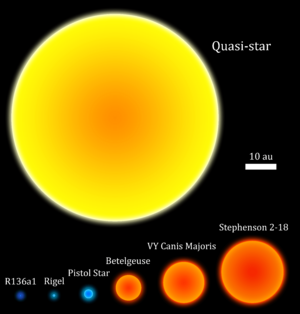Quasi-star facts for kids
A Quasi-star, sometimes called a black hole star, is a super-giant star that scientists believe might have existed very early in the universe. Imagine a star so big that it has a black hole right at its center! These stars were probably made mostly of hydrogen and helium, the simplest elements, which were common when the universe was young.
Contents
What is a Quasi-star?
A Quasi-star is a special type of star that is much, much larger than our Sun. It's so big that it could be about 10 billion kilometers across. To give you an idea, that's more than 7,000 times bigger than the radius of our Sun!
Instead of getting its energy from nuclear fusion like regular stars, a Quasi-star would get its energy from material falling into the black hole at its core. This means the black hole would constantly be "eating" gas from the star around it.
How did Quasi-stars form?
Scientists think Quasi-stars formed from very large protostars. A protostar is like a baby star, a big cloud of gas and dust that is just starting to pull itself together. In the early universe, there were huge clouds of gas. If a protostar grew very quickly and became extremely massive, it might have collapsed in the middle to form a black hole.
This black hole would then keep pulling in more gas from the surrounding protostar. This process would create a giant, puffy star with a black hole at its heart.
Why are Quasi-stars important?
Quasi-stars are important because they might help explain how supermassive black holes formed. Supermassive black holes are giant black holes found at the center of most galaxies, including our own Milky Way. They are millions or even billions of times more massive than the Sun.
Scientists are still trying to figure out how these huge black holes grew so big, so fast, in the early universe. Quasi-stars could be one answer. If a Quasi-star existed for a long time, its central black hole could have grown very large by constantly feeding on the star's gas. Once the star's gas ran out, the black hole would remain, already supermassive.
Related pages
Images for kids
-
A quasi-star rendered with Celestia
See also
 In Spanish: Cuasiestrella para niños
In Spanish: Cuasiestrella para niños



